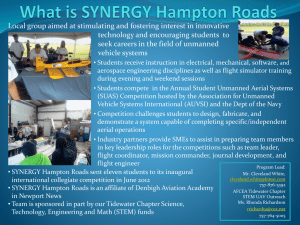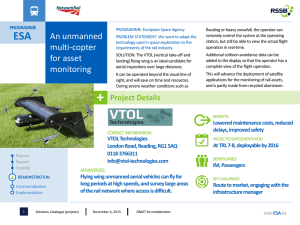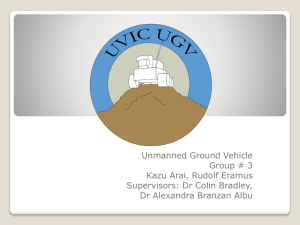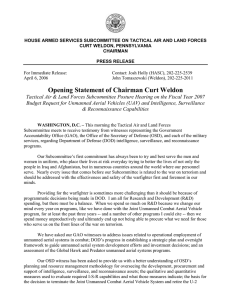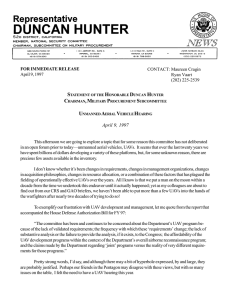A CONTRAST AMONG EXPERIMENTS IN THREE LOW-ALTITUDE UNMANNED
advertisement
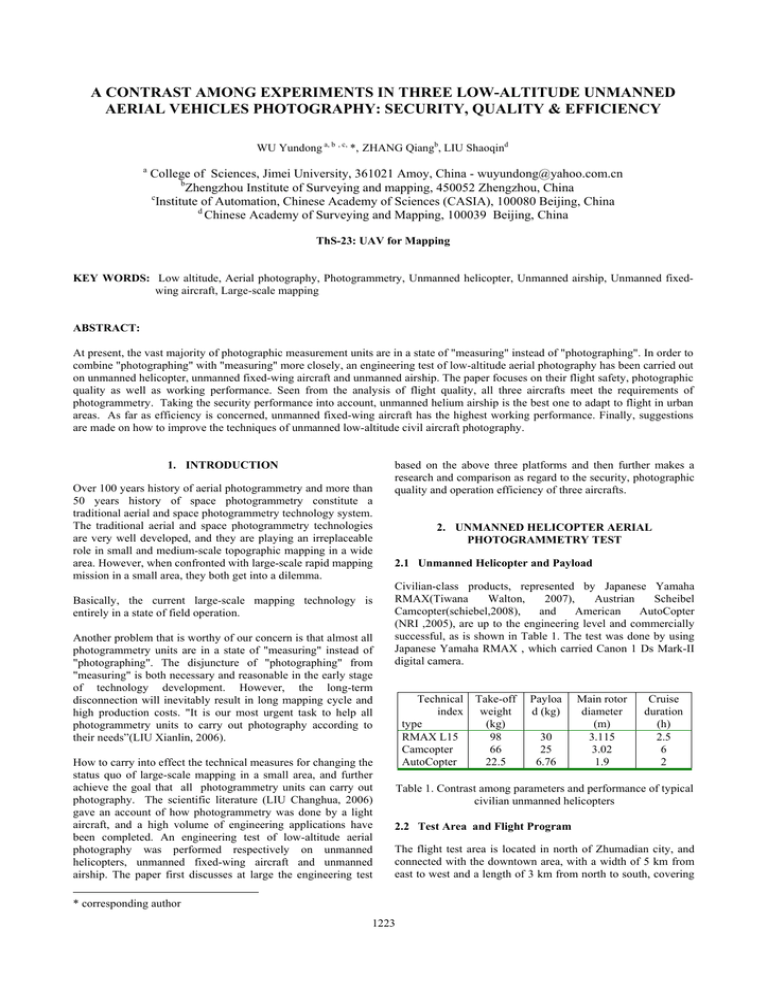
A CONTRAST AMONG EXPERIMENTS IN THREE LOW-ALTITUDE UNMANNED AERIAL VEHICLES PHOTOGRAPHY: SECURITY, QUALITY & EFFICIENCY WU Yundong a, b , c, *, ZHANG Qiangb, LIU Shaoqind a College of Sciences, Jimei University, 361021 Amoy, China - wuyundong@yahoo.com.cn b Zhengzhou Institute of Surveying and mapping, 450052 Zhengzhou, China c Institute of Automation, Chinese Academy of Sciences (CASIA), 100080 Beijing, China d Chinese Academy of Surveying and Mapping, 100039 Beijing, China ThS-23: UAV for Mapping KEY WORDS: Low altitude, Aerial photography, Photogrammetry, Unmanned helicopter, Unmanned airship, Unmanned fixedwing aircraft, Large-scale mapping ABSTRACT: At present, the vast majority of photographic measurement units are in a state of "measuring" instead of "photographing". In order to combine "photographing" with "measuring" more closely, an engineering test of low-altitude aerial photography has been carried out on unmanned helicopter, unmanned fixed-wing aircraft and unmanned airship. The paper focuses on their flight safety, photographic quality as well as working performance. Seen from the analysis of flight quality, all three aircrafts meet the requirements of photogrammetry. Taking the security performance into account, unmanned helium airship is the best one to adapt to flight in urban areas. As far as efficiency is concerned, unmanned fixed-wing aircraft has the highest working performance. Finally, suggestions are made on how to improve the techniques of unmanned low-altitude civil aircraft photography. 1. INTRODUCTION Over 100 years history of aerial photogrammetry and more than 50 years history of space photogrammetry constitute a traditional aerial and space photogrammetry technology system. The traditional aerial and space photogrammetry technologies are very well developed, and they are playing an irreplaceable role in small and medium-scale topographic mapping in a wide area. However, when confronted with large-scale rapid mapping mission in a small area, they both get into a dilemma. Basically, the current large-scale mapping technology is entirely in a state of field operation. Another problem that is worthy of our concern is that almost all photogrammetry units are in a state of "measuring" instead of "photographing". The disjuncture of "photographing" from "measuring" is both necessary and reasonable in the early stage of technology development. However, the long-term disconnection will inevitably result in long mapping cycle and high production costs. "It is our most urgent task to help all photogrammetry units to carry out photography according to their needs”(LIU Xianlin, 2006). How to carry into effect the technical measures for changing the status quo of large-scale mapping in a small area, and further achieve the goal that all photogrammetry units can carry out photography. The scientific literature (LIU Changhua, 2006) gave an account of how photogrammetry was done by a light aircraft, and a high volume of engineering applications have been completed. An engineering test of low-altitude aerial photography was performed respectively on unmanned helicopters, unmanned fixed-wing aircraft and unmanned airship. The paper first discusses at large the engineering test based on the above three platforms and then further makes a research and comparison as regard to the security, photographic quality and operation efficiency of three aircrafts. 2. UNMANNED HELICOPTER AERIAL PHOTOGRAMMETRY TEST 2.1 Unmanned Helicopter and Payload Civilian-class products, represented by Japanese Yamaha RMAX(Tiwana Walton, 2007), Austrian Scheibel Camcopter(schiebel,2008), and American AutoCopter (NRI ,2005), are up to the engineering level and commercially successful, as is shown in Table 1. The test was done by using Japanese Yamaha RMAX , which carried Canon 1 Ds Mark-II digital camera. Technical index type RMAX L15 Camcopter AutoCopter Take-off weight (kg) 98 66 22.5 Payloa d (kg) 30 25 6.76 Main rotor diameter (m) 3.115 3.02 1.9 Cruise duration (h) 2.5 6 2 Table 1. Contrast among parameters and performance of typical civilian unmanned helicopters 2.2 Test Area and Flight Program The flight test area is located in north of Zhumadian city, and connected with the downtown area, with a width of 5 km from east to west and a length of 3 km from north to south, covering * corresponding author 1223 The International Archives of the Photogrammetry, Remote Sensing and Spatial Information Sciences. Vol. XXXVII. Part B1. Beijing 2008 2 an area of about 15 km which includes highways, railways, transformer substations, high voltage wires, water systems and residential areas. The mapping scale is 1:1000, with a designed flight altitude of 236 m and GSD 10cm . Considering the aircraft flying capacity as well as emergency disposal, the test adopted a relatively secure flight strategy, i.e., autonomous flight under both program control and remote control within the visual range. Aircraft is always within the operator’s visual range while carrying out the flying mission autonomously. Once any abnormal condition occurs, the operator can conveniently switch to remote-controlled mode and take over the flight of the aircraft. In order to do this, we divide the experimental area into 6 × 4 horizon grids. As shown in Figure 1 (a), one flight is made within one grid and it is made one by one, making sure that the aircraft is always with a visual range of 450m. the largest rotation angle being 5°, the bending of the route being less than 1%, and the biggest aircraft height difference being 1m. Figure 2 (a) shows the thumbnails of 384 original images in the surveyed area. The directional mapping adopts overall field control, under which a total number of 300 control points are evenly laid out. For accuracy measurement, 130 points are evenly selected as check points, using aerial triangulation to minor control. Precision statistical result shows as follows: Mx = 0.12m , My = 0.10m , Mz = 0.15m , which meets 1:1000 topographic map surveying requirement. The subsequent photographic measuring produced and acquired 80 ortho images and vector diagrams. Figure 2 (b) shows the wall map of 1:5000 ortho image in the coverage. (a)Index image of the coverage (b)Orthoimage wall map Figure 2. Index image of the coverage and orthoimage wall map (a) Visual grid of the coverage (b) Route planning within one grid 3. AERIAL PHOTOGRAMMETRY EXPERIMENT ON UNMANNED FIXED-WING AIRCRAFT Figure 1.Visual Grids and Route Planning 3.1 Unmanned Fixed-wing Aircraft and Payload After the division of visual grids, route planning is made within the grid, i.e., to determine the horizontal location of each exposure station and select the flight route of the plane. The horizontal position of each exposure station can be calculated by the picture format, longitudinal overlap ( 60% ± 5% ) and lateral overlap ( 30% ± 5% ). To minimize the wind impact on posture as well as to ensure consistency of image rotation angle, we made the equidirectional flying principles of shooting from west to east and that head and end of two adjacent routes is connected by the transition route, as is shown in Figure 1 (b). In each flight, the ground station carries out real-time monitoring of flight condition and flight path of the aircraft, and the pre-monitoring signals of digital camera is also transmitted via wireless link to the ground stations. At the pre-set exposure station, the haeundae remote control sends out attitude control data and camera control data to complete haeundae leveling adjustment, the camera’s exposure metering and shooting tasks. After the flight mission is completed, the aircraft returns to the vicinity of its take-off point automatically and switches to mode of manual control to implement landing. 2.3 Test Results It took the flying crew of seven members six days of aerial photographing work to acquire a total of 384 images, each one being clear with uniform color without any aerial loopholes, and longitudinal overlap as well as lateral overlap are 100% qualified. All the indexes are in line with regulated requirements, with the largest photograph tilt angle being 2°, A number of aerial photogrammetry tests have been done on civilian unmanned fixed-wing aircraft. The document (CHEN Hongbin,2001) introduces an aerial remote sensing system based on a miniature autopilot plane, which is able to carry out fixed-point and fixed height shooting. The image resolution reaches decimeter level and it’s suitable for remote sensing surveys in unpopulated areas. The document (SUN Jie,2003) introduces a UAVRS-II UAV, the system of which takes plane array CCD digital cameras and single axes stable platform as airborne remote sensing equipment to acquire decimeterresolution remote sensing images that meet the 1:10000 scale mapping application requirement. The document (YAN Lei, 2004.) reports a UAV remote sensing systems which possesses man-machine performance as well as the functions of automatic taking off and landing. With a 30-hour biggest cruise duration, 100 kg payloads, the aircraft-borne remote sensing equipment may choose SAR, infrared, visible light CCD imaging equipment, but as is stated frankly in the paper, this UAV needs to further improve its cost performance to become sustainable management of remote sensing platform. This paper holds the belief that there is much room for improving the cost performance of the fixed-wing unmanned aircraft aerial photogrammetry system. The technical approaches concerned are to combine with professional application, enabling the system’s performance to meet the requirements in the professional field in order to avoid the resources waste cost by the simplified civil use of highperformance military aircraft. For this reason, aiming at the 1224 The International Archives of the Photogrammetry, Remote Sensing and Spatial Information Sciences. Vol. XXXVII. Part B1. Beijing 2008 small regional large-scale topographic mapping task, we present a new concept of aerial photographic system which employs a three-dimensional civil unmanned surveying biplane and takes the accuracy requirement as the main requirement of the system design. Meanwhile, the photograph control, double-wing UAV flight characteristics, the payload manufacturing requirements are taken as non-dominant requirements, using a multidisciplinary collaborative design model to carry on the optimal solution to the design parameters. The newly developed two-wing UAV which is with a length of 3.7 m, height 1.5 m and a wingspan of 3.5 m. The body of the plane uses aviation balsa skeleton, and the focus components use reinforced carbon fiberboard. The Airplane gross weight 40 kg, Take-off speed is 40 km/ h, Flying speed is 50 ~ 100 km/ h , cruise duration is 2h, control radius is 20 km , flight altitude is 100 m ~ 4 000 m, the DC—DC voltage transformation module provides the overall system with the standard 5 V and 12 V voltages. As shown in figure 3. The payload is a Canon 1DsMark-II digit camera. (a) Ground-pre flight state (b) 3.3 Test results With the flight altitude of about 118m, and the ground resolution of 5 cm, a total of 840 images are acquired in this aerial photographic task. The images are clear, with uniform color and no aerial loopholes. Both longitudinal overlap and lateral overlap are 100% qualified, the largest photograph tilt angle being 2°, the largest rotation angle 5°, the bending of the route less than 1%, and the largest aircraft height difference 3m. Figure 4 shows the thumbnails of the original images in the coverage. Directional points and checkpoints are totally field-controlled. After image distortion correction and single absolute orientation; the statistical results of the check point accuracy are as follows: Mx = 0.10m , My = 0.9m , Mz = 0.15m , which basically meet the 1:500 scale map requirements. Air ripcord state Figure 3. Unmanned aerial vehicle panorama drawing 3.2 Test Area Coverage and Flight Design After the integration of the system, it has been tested successively on such photogrammetry projects as antiregulation reservoir in Xixia Yuan, Guangzhou New Passenger Station on Wu-Guang Railway Passenger Line, Danjiangkou Reservoir, archaeology of Han Tomb and rural drinking-water projects in Huairou District, Beijing. Now we’ll take Guangzhou New Passenger Station for example. The test was carried out between October 1st and 6th, 2007. Guangzhou New Passenger Station on Wu-Guang Railway Passenger Line is located between Zhongcun Village and Shek Pik Village of Panyu District, Guangzhou, where Wu-Guang Railway Passenger Line intersects with the southern extension of Guangzhou Metro Line 2. The photography area is between east longitude 113°14'45'' - 113°16'35'' , and north latitude 22°58'47'' – 23°00'30'' . The actual flight area is 3.2 × 3.2 k m 2 . The survey area is flat with a distribution of rural residential areas, nurseries, orchards and farmland. The mode of manual take-off and landing is selected with autonomous flight. As the aircraft is equipped with a parachute, emergencies during the flight are handled autonomously by the aircraft-borne controller, therefore, only one landing field is set near the central zone of the surveyed area. The aircraft carries out the real task of over-horizon autonomous flight. Four crew members are involved and the effective operation time lasts three days, including one day for route planning. Figure 4. Index map of Guangzhou new passenger station 4. UNMANNED AIRSHIP AERIAL PHOTOGRAMMETRY TEST 4.1 Unmanned Airship and Payload The airship flies with the buoyancy of the helium filled in the ship pouch and the power provided by engine. In 1884, ever since the success of the world's first flight test of a practical airship, airship has become the most successful manned vehicle. As the airship is strongly affected by weather conditions such as winds and thunderstorms, airship was replaced by aircraft in the 1930s. However, people have never given up the development and application of unmanned airships for the sake of their unique technological advantages. Being eligible for lowaltitude and low-speed flight, small airships can be used as a unique platform for the acquisition of high-resolution remote sensing images. The unmanned airship used in this test is self designed and made by the Survey and Mapping Institute of Science and Technology of China. As is shown in Figure 4(a), the airship can fly autonomously and its performance is shown in table 2. A Canon 5D camera is used, the CCD size of which being 4368*2912, the focus being 24mm. 1225 The International Archives of the Photogrammetry, Remote Sensing and Spatial Information Sciences. Vol. XXXVII. Part B1. Beijing 2008 Length 14m Flight speed 30-50km/h Diameter 3.8m Flight altitude 50-600m Payload 10kg Control radius 20km Cruise duration 2h Control style Auto/manual Anti-wind performance 4 grade 5. THREE UNMANNED AERIAL PHOTOGRAMMETRY AIRCRAFT COMPARISON Based on the aerial photographic tests of the above-mentioned unmanned helicopter, unmanned fixed-wing aircraft and unmanned airship, the following review is made on the three low-altitude aerial photographic system as regard to their flight security, photographic quality and operation efficiency. 5.1 Security Comparison Table 2. Performance of the airship 4.2 Flight Design and Test results Located in Liede Village, Tianhe District, Guangzhou, a socalled "city village”, the task region covers a total area of nealy 1.0 square kilometers. The route design is in north-south direction, the length of each route being 1 km, the respective flight heights 300 m and 240 m , the longitudinal overlap 80% and lateral overlap 60% with horizontal placement of the camera. The 300m flight height parameters are as follows: 1. Image ground resolution is 0.1m; 2. Ground coverage is :436.8*291.2m; 3. Exposure interval in flight direction:58.2m, designed as 60m; 4. Route interval is 174m, designed as 150m; 5. The flight was carried out on October 10, 2007, with a 10person team, of which two are manipulators, one in ground station, three ground crew, two for logistics support, and two for data processing. We arrived at the field at 8:00am on the 10th of October, 2007. The air inflation started at 9:00a.m.. The unmanned airship took off at 12:20p.m., and landed at 12:50p.m.. We left the airfield at 13:30p.m. Security performances include two aspects: security of the system itself and safety of ground persons as well as properties. Especially in the case of a forced landing, the ground persons should have sufficient time to avoid collision. According to the analysis of failure probability, mechanical power equipment of unmanned helicopters is most complex, while that of airships and fixed-wing aircrafts are almost equivalent, being much simpler compared with helicopters. Therefore, unmanned helicopters have the highest failure probability. Considering the safety of ground persons, the spherical airship is made by strong composite film or senior PVC material, and the ball is filled with helium. Even when the airship has loopholes, it will still descend slowly. If an unmanned fixedwinged aircraft can open the parachute in time, slow descending can also be realized. With a main rotor, the parachute rescue equipment can’t be installed at the top of the unmanned helicopter so that it can not achieve slow descending. Though equipped with self-rescue devices(NRI ,2005) and a parachute will pop up from the rear of the helicopter in an emergency, the high speed rotating main rotor will still pose a threat to the unpredictable losses of ground persons and properties. Comparing the three equipments, unmanned airship has got the highest safety performance, while unmanned helicopter is least secure. 5.2 Quality Comparison (a) Panorama of the unmanned airship (b) Route Planning Figure 5. Panorama of the unmanned airship and route planning One main quality investigation is to inspect if an aircraft can realize cross-point flight according to the professional photogrammetry requirements. Based on the existing flight test analysis, the aerial photographic system of unmanned helicopters, unmanned fixed-wing aircrafts and unmanned airships can all meet the photogrammetry flight requirements. In contrast, the unmanned helicopter has the highest point accuracy, as seen in the 1 m photographic flying height changes of the 384 Zhumadian images. The accuracy of unmanned fixed-wing aircraft is in the second place, with the route height changes of less than 3 m in the 840 images of Guangzhou New Passenger Station. 5.3 Efficiency Comparison If the payload is definite, there are two primary factors that affect the working performance, i.e., location adaptability and cruise duration. Figure 6. Orthoimage of Liede Village, Tianhe District As far as location adaptability is concerned, unmanned helicopter does not need special take-off and landing sites and runways. Being capable of vertical take-off and landing, it doesn’t need special take-off and landing site in operation. With 1226 The International Archives of the Photogrammetry, Remote Sensing and Spatial Information Sciences. Vol. XXXVII. Part B1. Beijing 2008 suspended take-off and landing and without the need of a runway, unmanned airship would be the second choice, but a field of no shorter than three fuselage lengths is needed. A stadium within the city, a square or even a lawn can all serve as the landing fields, yet it hardly needs a landing field when flying outside the city. For unmanned fixed-wing aircrafts, there are restrictions on the airfield, the runway of which should be even and flat, have at least ten fuselage lengths and two wingspan widths. In addition, adequate headroom is also required. According to Guangzhou flight test, such technologies as catapult take-off, hit net recovery, water surface take-off and landing or a combination of both must be developed for an unmanned fixed-wing aircraft to better suit the flight in well-developed water networks and vegetation-intensive areas, which ensure that the unmanned fixed-wing aircraft can take off anywhere and at anytime. Under the conditions of no pixel compensation device, the maximum flying speed of a low-altitude unmanned aircraft will be restricted. Take the test in Zhumadian city for example, the provisions of pixel displacement is δ = 1/3 pixel, i.e., viz. 2.4μ . Meanwhile, the exposure time is set at t = 1 / 800 s , relative altitude at H = 236m , and altitude difference at Δh = 30m , focus at f = 17 mm , by which the maximum permitted speed can be calculated at w ≈ 84km / h . Therefore, it is particularly important to improve the range capability of an aircraft in speed- limited circumstances. The cruise duration of an unmanned helicopter, an unmanned fixed-wing and an unmanned airship used in the tests reported this paper is 2.5 h, 2h and 2h respectively, all of which needs further improvement. 6. CONCLUSION Through comprehensive analysis and summary of the experiment on aerial photogrammetry of unmanned helicopters, unmanned fixed-wing aircraft and unmanned airship, following conclusions can be drawn: 1. In regard to professional photogrammetry, all three systems of unmanned aircraft low-altitude aerial photogrammetry meet the requirements of small regional large-scale aerial photogrammetry. 2. Taking security, cost, efficiency into account, development of unmanned fixed-wing aircraft and unmanned airship should be given priority. Perfecting unmanned airship technology, solving the problem of flying in urban areas and improving the unmanned fixed-wing technology all help to realize highly efficient and secure flight in areas outside the city. 3. The development of low-altitude photogrammetry system of unmanned civil aircraft should be combined with professional application, matching the system's performance with professional requirements so as to avoid the waste of resources caused by the simplified civil use of high-performance military aircraft. 1. Three-axis stabilized platform technology, the key problem in low-altitude unmanned aircraft aerial photogrammetry system, needs further improvement. 2. The study of double-engine and double-generator unmanned fixed-wing aircraft helps to further improve the reliability and range capability of unmanned fixed-wing aircraft. 3. Payload swath is not only closely related with altimetric measurement accuracy, but is also an efficient way to improve the operating performance. At present, in the circumstances of limited single pixel CCD, the study of optical synthetic aperture camera is necessary. REFERENCES [1] LIU Xianlin, 2006. Survey and Mapping College Academic report [2] LIU Changhua, WANG Chenglong, LIU Xianlin, 2007. Analysis and application of a close-to-earth digital aerial photogrammetry system with over-light plane, Journal of Wuhan University (Natural Science ), 26(5), pp.523-528 [3] Tiwana Walton, 2007. Unmanned Aerial Vehicle Mission Planning to Kangerlussuaq,Greenland.http://nia.ecsu.edu/ur/ 0708/07summerinterns/tiwanawalton-technical-report-summer 2007.pdf. (accessed 25 April. 2008) [4] schiebel,2008. http://www.schiebel.net/ (accessed 25 April. 2008) [5] NRI ,2005, AutoCopter™ - Autonomous Unmanned Helicopter, http://www.airwarbirds.com/pdf/NRI-Multi-Produc t-Fact-Sheet-11.21.05.pdf. (accessed 25 April. 2008) [6] WU Yundong, ZHANG Qiang, WANG Hui et al, 2007. The Technique of Low Aerial Photography and Photogrammetry System by Unmanned Helicopter. Surveying Science and Technology Journal, 24(5), pp. 328-331 [7] CHEN Hongbin, MA Shuqing, WANG Gai, et al, 2001. Aerial remote sensing system based on micro-aircraft automatic driving aircraft. Remote sensing technology and application, 16(3): pp. 144-148 [8] SUN Jie, LIN Zongjian, CUI Hongxia, et al, 2003. Unmanned aircraft and space remote sensing monitoring system. Remote Sensing Information, (1), pp. 49-51 [9] YAN Lei, LU Shuqiang ZHAO Hongying, et al, 2004. Key technologies research of UAV aviation remote sensing systems. Journal of Wuhan University (Engineering Science). 37 (6), pp. 67-70 Following proposals are made to further improve the technology in low-altitude unmanned aircraft aerial photographic system: 1227 The International Archives of the Photogrammetry, Remote Sensing and Spatial Information Sciences. Vol. XXXVII. Part B1. Beijing 2008 1228
